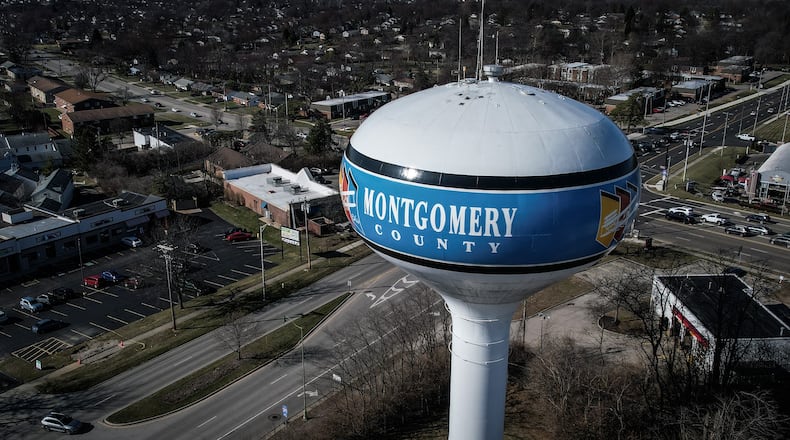“While we have operated as a good partner, we will not allow the county’s allegations to go unanswered. As a result of county’s allegations, the city must now zealously defend its position,” said Dayton law director Barbara Doseck.
The counterclaim is in response to a lawsuit Montgomery County filed in February. Montgomery County officials are seeking $14 million, alleging Dayton has been improperly overcharging Montgomery County for water services since 2018.
Water agreement
In addition to its own residents, Dayton supplies water to roughly 230,000 county residents. The communities that receive drinking water from Montgomery County include Kettering, Centerville, Riverside, Clayton and others.
Dayton and Montgomery County officials in 2018 agreed to a cost-of-service model, a mathematical formula that uses rolling averages based on the city’s expenditures and budgets to calculate water rate increases. Because of low inflation during the first few years of the COVID-19 pandemic, Dayton’s expenditures and budgets were reduced. This, in turn, reduced the rate the county paid for water, according to the city’s complaint.
“The county used the (formula) and years of low inflation to sell clean drinking water to its residents at what should have been a substantial profit for the county,” the city’s lawsuit says.
But over the past three years, Dayton has experienced “some of the largest inflation growths in decades,” the city’s complaint says.
“Now that the rolling averages are based on three years of higher inflation, the county is required to pay closer to market value for its water,” the city’s complaint says.
Montgomery County consumes 57% of Dayton’s water supply, yet only accounts for 41% of the city’s water revenue, according to the city’s counterclaim.
“A deviation from the (formula) would require the city to further subsidize the county’s water,” the city’s counterclaim states. “The city cannot and should not have to subsidize the county’s water as a result of the county’s inefficient operations and fiscal management. Doing so would be a disservice to city ratepayers.”
Dayton officials received a letter from the county in December 2023 requesting an amendment to the formula used in the agreement. City leaders declined to amend the formula.
“The city’s refusal to write new terms into the agreement has been met with unwarranted political pressure for the city to subsidize the county’s water rates — despite the county overcharging its residents for water and failing to properly allocate and manage its water revenue,” the city’s counterclaim alleges.
DM-5 pump station
As a part of the 2018 water agreement, the county agreed to create a new pump station, called DM-5, within 10 years of the agreement’s signing. The city was required to construct $700,000 worth of necessary infrastructure to provide a supply of water from the city’s pump station to DM-5.
DM-5 was intended to go between Dayton and the Greater Moraine Water System, according to Dayton’s 2021 Water Quality and Infrastructure Review report.
The counterclaim alleges that the construction of DM-5 was material to the entire agreement between Dayton and Montgomery County.
“Specifically, the rate terms negotiated between the city and the county were adjusted to account for the county’s agreement to construct DM-5, affording the county more favorable rate terms in exchange for its obligation to do so,” the city’s complaint states.
Montgomery County officials have not applied for permits or completed any other action that would allow the pump station to be completed within the agreed-upon 10-year timeframe, the city argues. And during a March 10 meeting between the city, the county and legal firm Brown and Caldwell, county representatives refused to respond to a question related to their plans for constructing DM-5.
“The county allowed the city to make such expenditures despite knowing that it was not going to build DM-5 as required under the agreement,” the city’s counterclaim states.
The Dayton Daily News reached out to the county for clarity on its plans for the DM-5 pump station The county is working on a response, officials said Tuesday.
Water quality
The county’s February complaint includes concerns surrounding per-and poly-fluoroalkyl substances, or PFAS, in the city’s water.
PFAS are a group of powerful, toxic chemicals created to be resistant to heat and other elements. PFAS are very difficult to break down due to their chemical composition, which consists of strong bonds of fluorine and carbon atoms. For this reason, they are often referred to as “forever chemicals.”
The county complaint points to a lawsuit the city of Dayton filed in 2018 against company 3M for forever chemicals contamination, with the city alleging “significant injury and damage” from PFAS detected in the city’s water supply wells.
The city’s counterclaim said Dayton informed Montgomery County and the general public about its PFAS levels before the 2018 agreement was signed through water reports published in 2016, 2017 and 2018.
The city is also working to comply with all PFAS regulations by the national 2029 deadline for public water systems.
“The county added this claim for the sole purpose of imposing additional political pressure on the city, in bad faith, to force the city to amend the agreed model and subsidize the county’s water rates,” according to the city’s counterclaim.
About the Author

